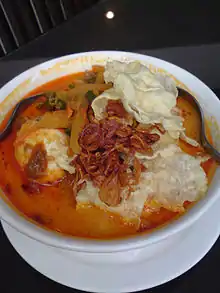 Emping melinjo | |
| Course | Snack |
|---|---|
| Place of origin | Indonesia[1] |
| Region or state | Limpung, Batang |
| Serving temperature | Room temperature |
| Main ingredients | Deep fried dried Gnetum gnemon nut |
| Variations | Plain, salty, sweet and spicy hot |
Emping is a type of Indonesian chip, a bite-size snack kripik cracker, made of melinjo or belinjo (Gnetum gnemon) nuts (which are seeds). Emping crackers have a slightly bitter taste.[1] Emping snacks are available in markets plain (original), salty, spicy, or sweet, depending on the addition of salt or caramelized sugar.
Production

Emping production is a home industry, with emping traditionally handmade in a labor-intensive process. The melinjo seeds are sauteed in a medium fire without oil, or sometimes using sand as a media. Some people boil the melinjo seeds to ease the peeling process. Both the softer outer skin and the harder inner skin of the seeds are peeled off by hand. Each of the gnetum seeds is whacked with a wooden hammer-like instrument or pressed with a stone cylinder to create flat and round emping, and later arranged in a tray made of weaved bamboo and sun-dried for a whole day. Each emping chip is commonly created from a single gnetum nut, although there are variants that combine several seeds to create larger emping with sizes similar to krupuk. These large emping, however, are often mixed with other types of starch, such as corn or tuber starch. There are two types of emping thickness available in markets, thin and thick. Thin emping are usually plain or salty, while thick emping are usually sweet, coated with caramelized sugar, or spiced with chili pepper.
The dried emping chips are collected, packed, and sold at the market. Raw emping, as bought from traditional markets, are better when sun-dried first to reduce their humidity, then later fried with ample hot vegetable oil until they expand, becoming crispy and turning golden yellow. Emping is produced in many parts of Indonesia, from Limpung in Central Java, Pidie in Aceh to Sulawesi. However, the main production areas are in Java, with Karangtawang village in Kuningan Regency West Java;[2] Bantul Regency in Yogyakarta; Klaten Regency and Batang Regency, in Central Java; and Magetan Regency in East Java.
Consumption

Raw (unfried) emping is usually available in Indonesian traditional markets, while in snack stores, supermarkets, and restaurants mostly pre-packed, ready-to-eat emping is available. Most emping are flavoured (original), and served with a pinch of salt. Emping has been exported to the Netherlands, the USA ,and the Middle East. In the Netherlands, due to historic ties with Indonesia, packaged dried (raw) emping is also available for home frying. These are to be found in Indonesian specialty stores referred to by Indonesian names such as "Toko" or "Warung" (both meaning shop or store).
Emping is frequently served solely as a snack or accompaniment to Indonesian traditional dishes. They are often added as a crispy addition to Indonesian dishes such as soto, nasi uduk, sop buntut, gado-gado, lontong sayur, nasi goreng, nasi kuning, laksa and bubur ayam.
See also
References
- 1 2 "Emping Melinjo Manis (Indonesian Sweetened Paddy Oats Crackers)". Indonesia eats. 23 May 2011. Retrieved 2 July 2012.
- ↑ "Emping Khas Karangtawang Diminati" (in Indonesian). Kuningan News. 2 July 2012. Archived from the original on 27 January 2013. Retrieved 2 July 2012.